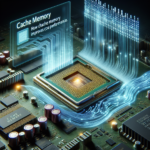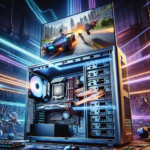The Impact of CPU on Streaming and Content Creation

The Impact of CPU on Streaming and Content Creation
In the digital age, streaming and content creation have become ubiquitous activities, with millions of people engaging in these pursuits either professionally or as a hobby. The central processing unit (CPU) plays a critical role in these activities, influencing performance, quality, and efficiency. This article delves into the impact of the CPU on streaming and content creation, exploring its importance, how it affects various tasks, and what to consider when choosing a CPU for these purposes.
Understanding the Role of the CPU
What is a CPU?
The CPU, or central processing unit, is often referred to as the “brain” of a computer. It performs the majority of the processing inside a computer, executing instructions from programs and managing the flow of information through the system. The CPU’s performance is crucial for a wide range of tasks, from basic operations to complex computations.
Key CPU Metrics
Several metrics determine a CPU’s performance:
- Clock Speed: Measured in gigahertz (GHz), this indicates how many cycles a CPU can perform per second. Higher clock speeds generally mean faster performance.
- Core Count: Modern CPUs have multiple cores, allowing them to perform multiple tasks simultaneously. More cores can significantly improve multitasking and parallel processing.
- Threads: Threads are virtual cores that help in executing tasks more efficiently. CPUs with hyper-threading technology can handle more threads, enhancing performance.
- Cache Size: The cache is a small amount of high-speed memory located on the CPU. Larger caches can store more data for quick access, improving performance.
- Thermal Design Power (TDP): This measures the heat output and power consumption of the CPU. Lower TDP values are preferable for energy efficiency and cooling.
The CPU’s Impact on Streaming
Encoding and Decoding
One of the primary tasks in streaming is encoding and decoding video and audio data. Encoding involves compressing video and audio into a format suitable for streaming, while decoding involves decompressing the data for playback. The CPU plays a crucial role in these processes:
- Software Encoding: This relies heavily on the CPU. Higher clock speeds and more cores can significantly improve encoding performance, resulting in smoother streams and higher quality.
- Hardware Encoding: Some CPUs come with integrated graphics that support hardware encoding, offloading some of the work from the CPU. This can free up resources for other tasks and improve overall performance.
Multitasking
Streaming often involves multitasking, such as running the streaming software, playing a game, and managing chat windows simultaneously. A CPU with more cores and threads can handle these tasks more efficiently, reducing lag and ensuring a smooth streaming experience.
Quality Settings
The quality of a stream, including resolution and frame rate, is directly influenced by the CPU’s capabilities. Higher-end CPUs can handle higher resolutions (such as 1080p or 4K) and higher frame rates (such as 60fps) without compromising performance. This results in a better viewing experience for the audience.
The CPU’s Impact on Content Creation
Video Editing
Video editing is a CPU-intensive task that involves rendering, applying effects, and exporting videos. The CPU’s performance can significantly impact the speed and efficiency of these processes:
- Rendering: Faster CPUs with more cores can render videos more quickly, reducing the time it takes to produce a final product.
- Effects and Transitions: Applying effects and transitions in video editing software requires substantial processing power. A powerful CPU can handle these tasks more smoothly, allowing for real-time previews and faster editing.
- Exporting: Exporting the final video file is another CPU-intensive task. A high-performance CPU can reduce export times, enabling creators to publish their content more quickly.
Graphic Design
Graphic design software, such as Adobe Photoshop and Illustrator, also relies heavily on the CPU. Tasks such as image manipulation, applying filters, and working with large files can benefit from a powerful CPU:
- Image Manipulation: Editing high-resolution images and applying complex filters require significant processing power. A faster CPU can handle these tasks more efficiently, improving workflow.
- Multitasking: Graphic designers often work with multiple applications simultaneously. A CPU with more cores and threads can manage these tasks better, reducing lag and improving productivity.
3D Rendering and Animation
3D rendering and animation are some of the most CPU-intensive tasks in content creation. Software like Blender, Maya, and 3ds Max require substantial processing power to render complex scenes and animations:
- Rendering: Rendering 3D models and animations can take hours or even days, depending on the complexity. A high-performance CPU can significantly reduce rendering times, allowing creators to iterate more quickly.
- Simulation: Simulating physics, particles, and other effects in 3D software requires substantial CPU power. A faster CPU can handle these simulations more efficiently, improving workflow and productivity.
Choosing the Right CPU for Streaming and Content Creation
Factors to Consider
When selecting a CPU for streaming and content creation, several factors should be considered:
- Budget: High-performance CPUs can be expensive. It’s essential to balance performance needs with budget constraints.
- Core Count and Threads: More cores and threads can improve multitasking and parallel processing, essential for streaming and content creation.
- Clock Speed: Higher clock speeds can improve single-threaded performance, crucial for tasks that rely on single-core performance.
- Compatibility: Ensure the CPU is compatible with your motherboard and other components.
- Future-Proofing: Consider investing in a CPU that will remain relevant for several years, accommodating future software updates and performance demands.
Recommended CPUs
Here are some recommended CPUs for streaming and content creation:
- AMD Ryzen 9 5900X: With 12 cores and 24 threads, this CPU offers excellent performance for both streaming and content creation. Its high clock speeds and large cache make it a top choice for demanding tasks.
- Intel Core i9-11900K: This CPU features 8 cores and 16 threads, with high clock speeds and strong single-threaded performance. It’s an excellent choice for tasks that require both single-core and multi-core performance.
- AMD Ryzen 7 5800X: With 8 cores and 16 threads, this CPU offers a good balance of performance and price. It’s suitable for both streaming and content creation tasks.
- Intel Core i7-11700K: This CPU features 8 cores and 16 threads, with strong performance for both streaming and content creation. It’s a good option for those looking for high performance without breaking the bank.
FAQ
How important is the CPU for streaming?
The CPU is crucial for streaming, as it handles encoding, multitasking, and quality settings. A powerful CPU can improve stream quality, reduce lag, and ensure a smooth streaming experience.
Can I use a gaming CPU for content creation?
Yes, many gaming CPUs are suitable for content creation. CPUs with high core counts and clock speeds can handle both gaming and content creation tasks efficiently.
Is it better to have more cores or higher clock speeds?
It depends on the tasks you perform. More cores are beneficial for multitasking and parallel processing, while higher clock speeds improve single-threaded performance. For streaming and content creation, a balance of both is ideal.
Do I need a dedicated GPU for streaming and content creation?
While a powerful CPU is essential, a dedicated GPU can also improve performance, especially for tasks like video editing, 3D rendering, and gaming. GPUs with hardware encoding support can offload some of the work from the CPU, enhancing overall performance.
How can I optimize my CPU for streaming and content creation?
To optimize your CPU, ensure proper cooling, keep your system updated, and close unnecessary background applications. Overclocking can also improve performance, but it should be done cautiously to avoid overheating and instability.
Conclusion
The CPU plays a pivotal role in streaming and content creation, influencing performance, quality, and efficiency. Understanding the impact of the CPU on these activities can help you make informed decisions when selecting hardware. By considering factors such as core count, clock speed, and budget, you can choose a CPU that meets your needs and enhances your streaming and content creation experience. Whether you’re a professional content creator or a hobbyist streamer, investing in a powerful CPU can significantly improve your workflow and output quality.




